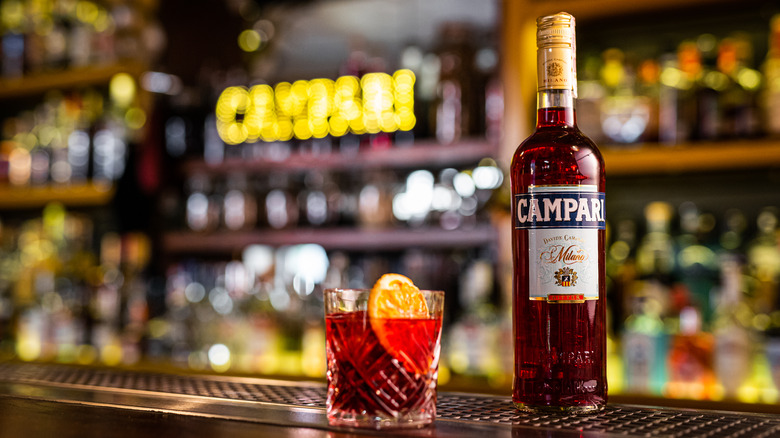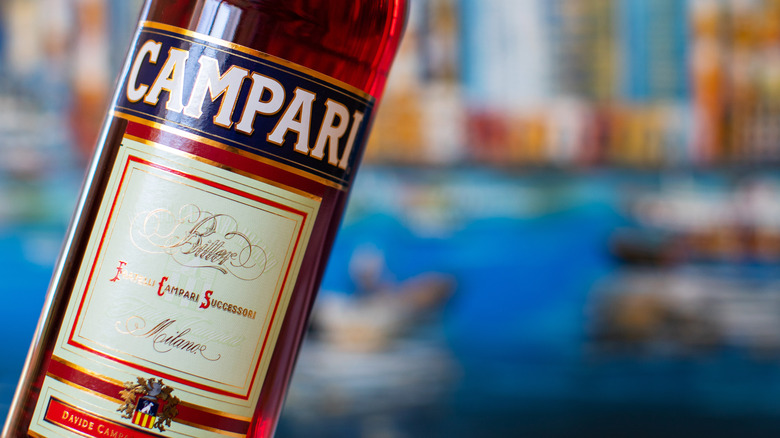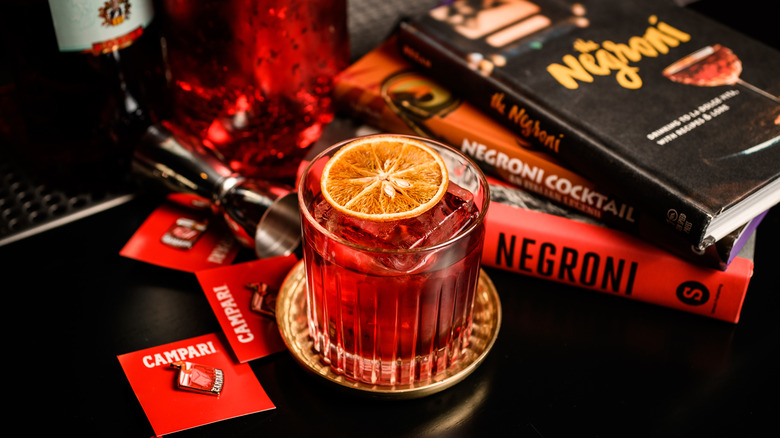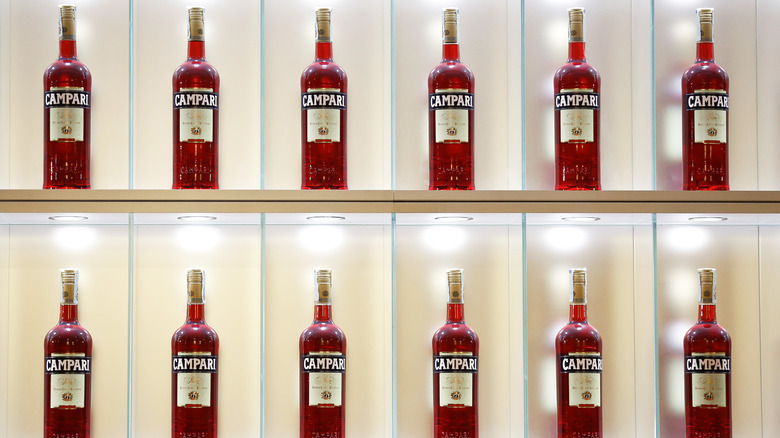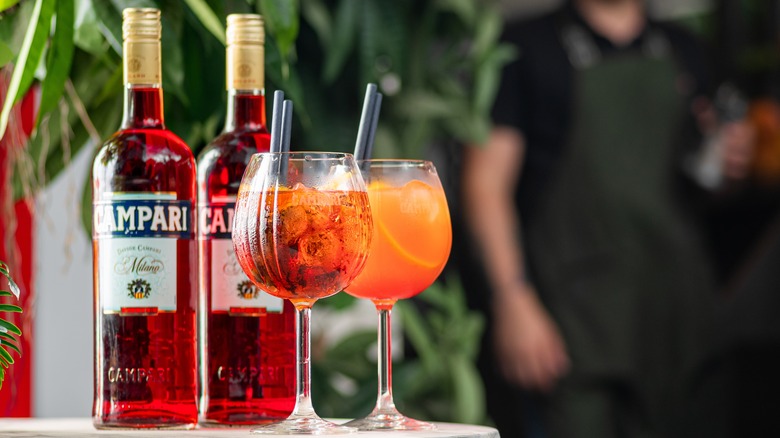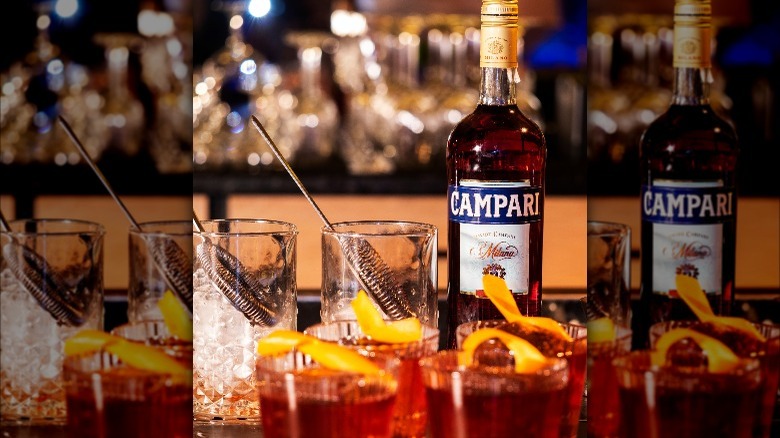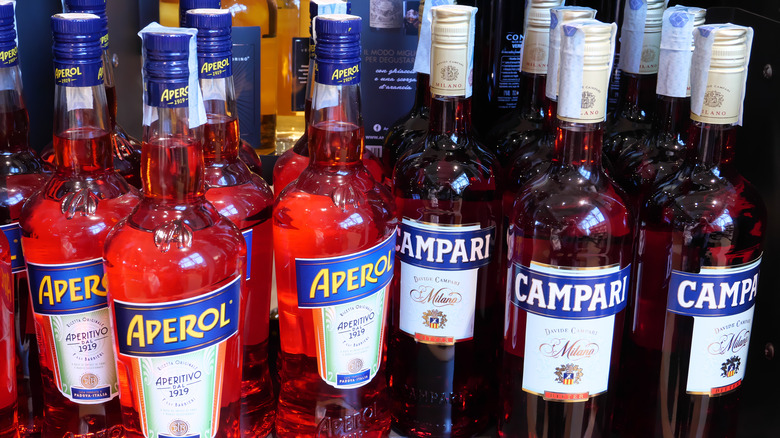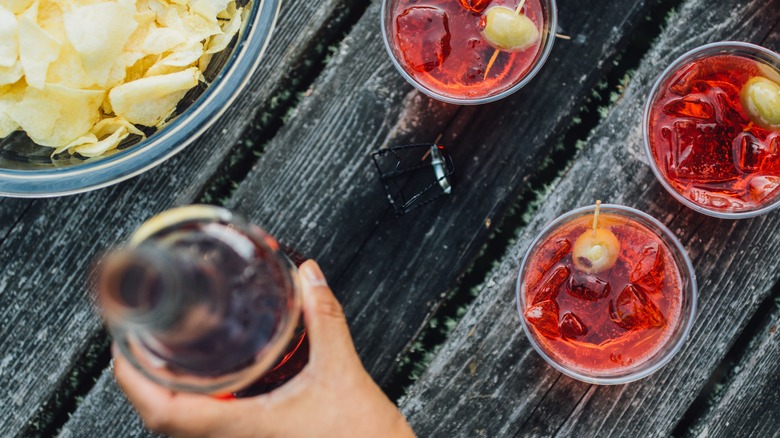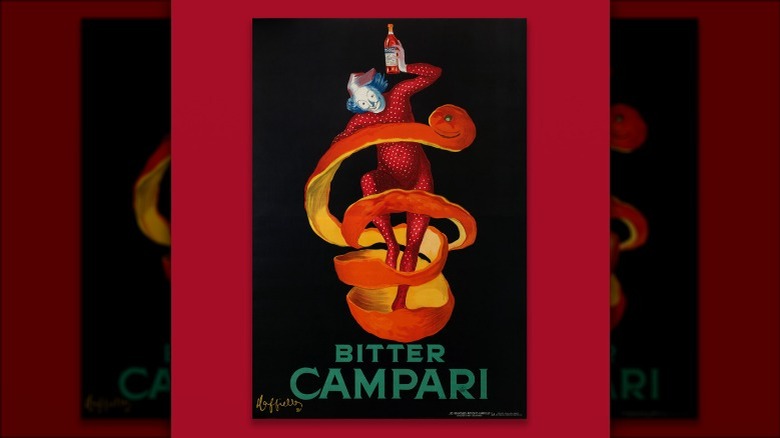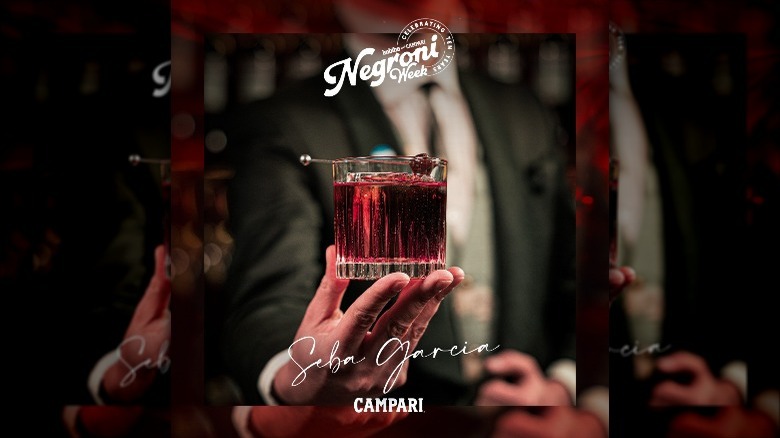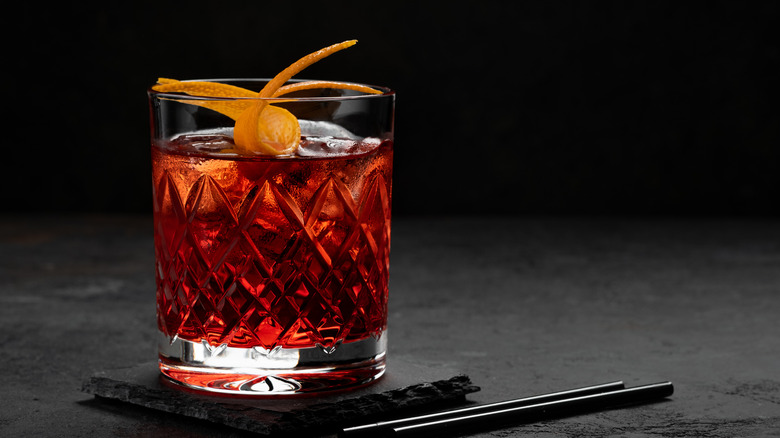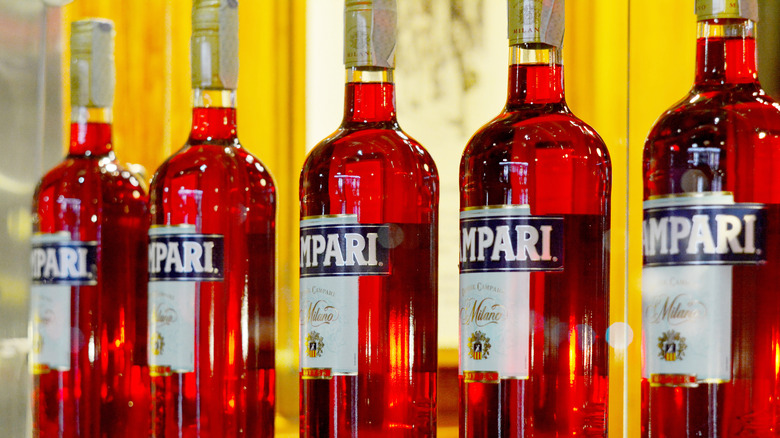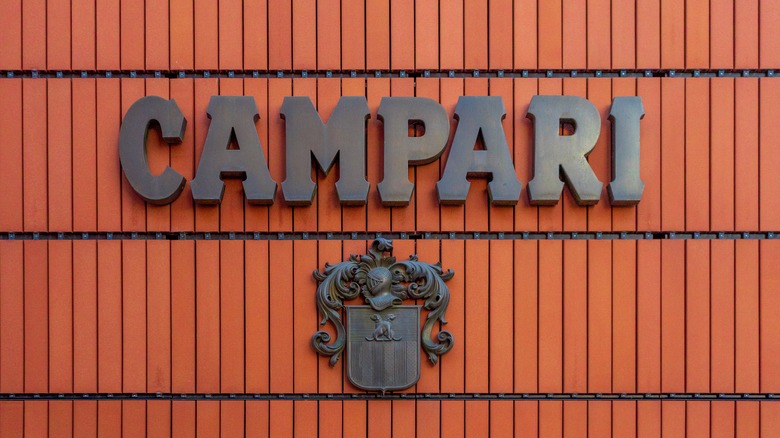Campari: Everything You Need To Know
Campari is a crimson bitter liqueur that every respectable bar always has on hand. It's hard to fathom that a drink whose history began in the mid-19th century is now the best-selling liqueur brand in the world (via Drinks International). Campari was so timelessly crafted from the start that it managed to adapt to the ever-changing trends in the beverage industry. Made with a secret blend of ingredients, it has long surpassed the borders of its native Italy and can be found gleaming its vibrant red hue from bars worldwide.
Campari is best described as an aperitif or a drink that should be served before meals. It became best known as Milan's signature aperitif paired with fizzy soda for a balanced tipple, but Campari's role extends beyond spritzes. It is now known as an indispensable element in classic cocktails, notably the Negroni which enjoys the title of the best-selling cocktail in the world, according to Drinks International.
The low-proof liqueur is favored for its complex flavors and aromas which stem from a secret blend of numerous botanicals. The result is floral and herbal, with a palate dominated by a lingering bitterness complemented by fruity and herbal notes (via Drinks Enthusiast).
Part of its success is also attributed to innovative marketing techniques and clever brand placements that made Campari an iconic bar label that dominates the beverage industry as a multinational powerhouse under the Campari Group.
Campari originated before Italy even existed
Campari's story began in 1860, one year before the country was officially unified as The Kingdom of Italy (per Britannica). The beverage was created by Gaspare Campari, who managed to make a liqueur so unique that his original recipe is still used to this day. Campari experimented with different types of liqueurs, but the red-hued bitter was the most valuable creation. Campari eventually moved from Novara, Piedmont, to Milan, where he opened a café in the grand Galleria Vittorio Emanuele II, located in the dead center of the city. It was a strategic move that attracted upscale locals who instantly fell for the bitter liqueur.
Campari's son Davide had even bigger aspirations and focused only on Campari as a signature liqueur. He allowed other bar owners to sell it and took the business outside its native country. The success led to the first Campari factory in Milan and later to a mechanized shop in the surrounding region.
Davide passed away in 1936, and the company was sold to a distant cousin. Although Campari wouldn't exist without Gaspare, it was Davide who made it legendary. For this reason, the label still carries his name as an homage to the man who made Campari a household name in and outside its native Italy (via Difford's Guide).
Campari's original recipe is a secret and includes various botanicals
Campari has never disclosed the recipe for its signature liqueur, but there are many guesses as to which botanicals create the aromatic and complex drink. According to Difford's Guide, the company has only confirmed the use of orange zest, and other guesses include rhubarb, quinine, ginseng, chinotto, and cascarilla. In total, Campari is made with 68 different ingredients, so it's not surprising that it results in such a complex drink.
Although nobody knows exactly what goes inside Campari, it's hard not to love its bitter and herbaceous character. The liqueur stands out with its vibrant crimson color, which lends an attractive hue to mixed drinks that call for a bitter element. But really, the flavor and aroma make it a winner in the liqueur department. Campari is dominated by citrus notes along with herbaceous bitterness, spices, and a hint of vanilla (via Flaviar).
Only one person knows the exact recipe
Campari is still made according to the original recipe — minus the coloring agent which was tweaked in 2006 (per Difford's Guide) — but the exact composition and the ingredients that make Campari have never been officially revealed to the public. According to Saveur, the factory's director is the sole person who knows the exact recipe, ensuring this remains the case by receiving ingredients packaged in plain brown bags with no labels. Although the actual ingredients are unfamiliar, the process involves steeping dry botanicals in water, combining them with alcohol and more water, and leaving the mixture to macerate until all the flavors are extracted. The resulting bitter base is then sweetened, colored, and adjusted with water to attain its lighter character.
However, not all Campari bottles are created equal. Difford's Guide explains that Campari's strength varies depending on the regional market. The eastern European market has the highest ABV creeping over 28%, while African countries get a low-proof Campari of around 20% ABV. Also, it seems that the "bitter" moniker didn't go well in the U.S. market, so bottles usually simply feature "aperitivo" on the label.
Campari is the base of many classic cocktails
Campari is best known as a great cocktail ingredient — the most popular being the legendary Negroni – but the versatile character of this vibrant liqueur offers many other pairing possibilities. As Melissa Romanos shared with Liquor.com, the fruity, spicy, and herbal notes found in Campari perfectly complement various flavors, such as "citrus, pineapple, berries, basil, thyme, and baking spices." Romanos also says that it could work with several cocktail styles, like tiki and sours or beer-based mixed drinks.
Other classics that shouldn't be ignored include the original Campari & soda, which was the ideal aperitif concocted by Davide Campari at The Camparino bar in Milan. It was so popular that in 1932 Davide had it bottled, creating the world's first fizzy bottled cocktail. Other drinks like the Garibaldi which combines Campari with orange juice and the iconic Americano (mixed with sweet vermouth), are some of the creative combinations in which Campari plays a leading or supporting role.
Alternatively, if you prefer bitter flavors, there is no reason not to serve a shot of Campari on the rocks. Without additional flavorings, the beautifully crafted bitter and herbal notes really shine through.
It is a mid-priced liqueur that won't break the bank
In 2021, the Campari Group announced that it would increase the price of all the company's labels to varying degrees. The rise is a result of Campari's effort to keep up with the surging cost of logistics. Bob Kunze-Concewitz, Campari's CEO, explained to Bloomberg that while the company benefited from post-pandemic bar openings and is fortunate to have base ingredients such as sugar, alcohol, and packaging at hand, it still can't meet all the costs with its current prices.
Despite the increase, Campari remains a reasonably priced liqueur. Depending on the size, you can expect to pay around $20 for small 375ml bottles to over $40 for a large 1L bottle. Campari is rarely sipped solo so a bottle will last for some time, and you can use it to whip up a decent number of Negronis. It also has a relatively long shelflife, so feel free to store it in the pantry. Once open, Cocktail Hammer recommends using it within a year, though we highly doubt anyone has kept a Campari bottle around for that long.
Campari vs Aperol
Campari is most often linked to Aperol, and though the two have much in common, the former is best described as a stronger, more bitter older brother to the latter. Aperol and Campari fall in the aperitif category, meaning they were concocted as bitter liqueurs meant to be sipped before a meal. They share a similar flavor profile — think herbal, bitter, and citrus — but as the brands have never fully disclosed the recipes, it's difficult to determine the distinction based on ingredients alone.
When it comes to main differences, one is clearly visible; Aperol has a vibrant orange color while Campari displays a distinctive crimson hue. In the alcohol department, Campari clocks a higher ABV (ranging from 20 to 29% depending on the market), while Aperol has a modest 11% ABV. Although both are considered low-proof, Campari can lend more kick to cocktails and mixed drinks. Also, Aperol is slightly sweeter, making it ideal for lighter combinations that need a touch of orange bitterness. On the other hand, Campari is best used for beefy cocktails such as an Americano or Negroni (via MasterClass).
Campari is an essential part of Italian aperitivo culture
Aperitivo is a quintessential Italian tradition best described as an upgraded version of a happy hour (via Eataly). It typically involves gathering over drinks and small bites, and though it is found throughout the country, the custom was born in the north of Italy and has been intricately connected with Milan and Turin (via Liquor.com). In Turin, Antonio Benedetto Carpano invented vermouth, which would become the first aperitivo. Meanwhile, Milan acted as the spiritual home of Campari, which soon evolved into the city's signature aperitif drink.
During aperitivo time, Campari can be enjoyed in various shapes and sizes, though it makes a perfect fizzy spritz mixed with soda water and Prosecco. Since the tradition is meant to whet your appetite, you'll find a range of options including substantial buffets, plates with assorted snacks, or bowls of salty snacks (via Walks of Italy).
The brand has always had a creative approach to marketing
For most of its history, Campari has paid close attention to branding and marketing. The company has always ensured that it delivers creativity by partnering with some of Milan's greatest artists. Davide Campari collaborated with some of the most prominent Italian artists of his time who made poster ads for the Campari brand (via Eye on Design). The most significant artistic influence was Fortunato Depero, a futurist who introduced the distinctive geometrical design to the brand's portfolio.
Davide Campari's flirtations with art were novel, and he must have realized that exciting design and marketing would help build a strong brand. He worked with avant-garde sometimes controversial artists, who had almost complete autonomy over the design art. When you investigate Campari's marketing history, you'll notice that most European contemporary art movements of the early 20th century are replicated in its campaigns. Even the Campari Soda bottle, created by Depero in 1932, remains an inspirational design that is still talked about today, Mohd reports.
Campari is one of the sponsors of Negroni Week
It seems that Negronis are everywhere these days. In 2021, this classic was crowned the cocktail of the year by The Guardian, and it topped the list of best-selling cocktails for 2022 after spending eight long years as the forerunner to the Old-Fashioned. One might think that this fame implies a young, hip cocktail, but Negroni is anything but that. It was allegedly invented in 1919 by Count Negroni, who asked a bartender to whip him up an Americano by replacing club soda with gin, resulting in the final formula of Campari, sweet vermouth, and gin (via Condé Nast Traveler).
In line with its newfound fame, Negroni Week was created to celebrate all things Negroni. Naturally, Campari is one of its main sponsors. The boozy week takes place in September and involves creating, mixing, and serving various classic and innovative Negroni cocktails in bars and restaurants across the world. Apart from its festive nature, the event has a charitable cause as all venues donate to their chosen charity by registering on the Negroni Week website. We can't think of an easier or more enjoyable way to support a cause than by sipping on a Negroni.
Campari was originally dyed with bugs
If you've ever seen a bottle of Campari, then you've certainly noticed its bright red hue. It is arguably one of the easiest ways to single it out among other similar liqueurs. Gaspare Campari was the one who chose to go with the vibrant scarlet color. To produce it he decided to use carmine, a natural dye extracted from cochineal, which are tiny bugs native to South America. That's right, Campari's signature color originally comes from crushed bugs (via VinePair). Rest assured that the Campari you're used to sipping probably wasn't made with bugs.
In 2006, Campari stopped using cochineal and opted for artificial coloring, according to The New York Times. There are various theories as to why the brand decided to drop it, and the company itself mentioned a potential lack of future supply. Other sources speculated the intention was to make Campari suitable for vegans or anyone who couldn't handle the idea of sipping on something made with bugs (via VinePair).
It is a benchmark for other aperitif liqueurs
We can safely say that Campari is not going anywhere thanks to its role in popular cocktails and as a stand-alone liqueur. It appears that Gaspare Campari created a perfect blend that has managed to thrive for over 150 years. Other liqueurs can hardly compare to its seductive character and ability to effortlessly blend with various spirits and mixers. Still, if you decide that you are ready to step out of that comfy Campari zone and tweak your Negroni recipe, there are different Italian-style aperitif liqueurs for you to uncover.
Cappelletti differs from the traditional Campari character, as it's a lighter and sweeter option (via Difford's Guide). Meanwhile, Meletti 1870 is a better fit to mimic Campari's flavor profile. If you decide to further explore the red aperitivo market, keep in mind that Campari has a strong character that is not easy to match. Alternatively, if you're using Campari as a replacement, only use it in mixed drinks that call for equally bold liqueurs, as it can quickly overpower.
The brand grew into a large international spirit company
Campari may have been introduced in the mid-19th century as a house-crafted liqueur, but these days the name is not only synonymous with the world's best-selling liqueur but also with a business success story. Campari is now sold under the Campari Group, whose development started with the first business purchase in the mid-1990s. At the turn of the century, the company expanded with several acquisitions that included Italian and international brands, making it one of the top players in the competitive beverage market.
Campari Group continued to grow and currently owns more than 50 high-quality brands across all beverage departments. The company's portfolio includes Aperol, Cynar, and Averna as some of the top Italian brands, along with big international names such as Appleton Estate, Wild Turkey, and the legendary French liqueur Grand Marnier (via LinkedIn). The decision to pursue external growth while building a strong brand image proved to be a savvy and fruitful strategy, and Campari Group is currently the sixth-largest spirits group in the world.
It also shows no signs of slowing down as evidenced by a massive increase in sales noted in the 2021 annual report (via Spirits Business). One of the biggest winners was its signature Campari liqueur, which experienced a 30.1% rise in sales. These results align with the recent mixology trends in which Campari plays a pivotal role.
